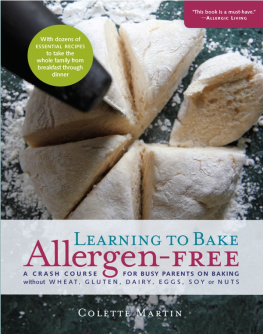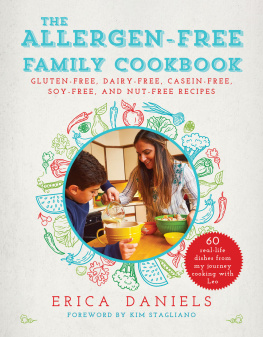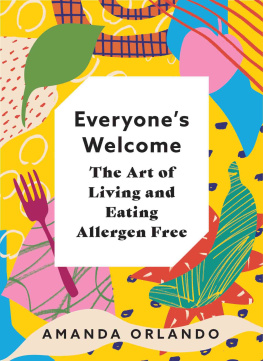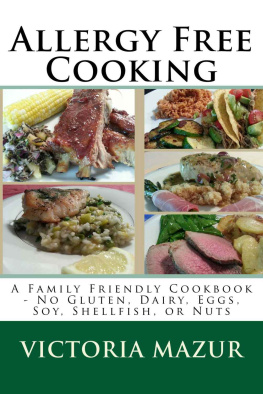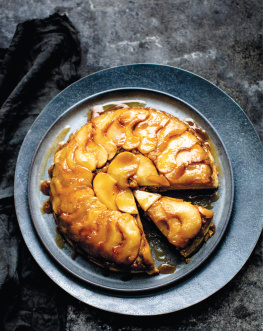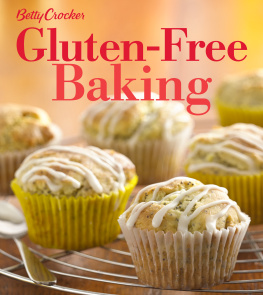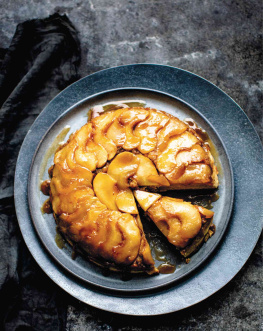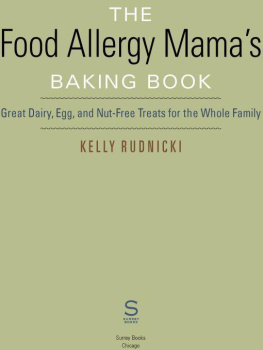About the Author
*
COLETTE MARTIN is a food-allergy mom and an expert on how to bake allergen-free. When her son was diagnosed with multiple food allergies, she had to reinvent how her family ate. Having first learned to bake in her grandmothers kitchen with wheat, butter, milk, and eggs, Colette understands firsthand what it means to transform a kitchen to accommodate multiple food allergies.
You can visit her website, .
*
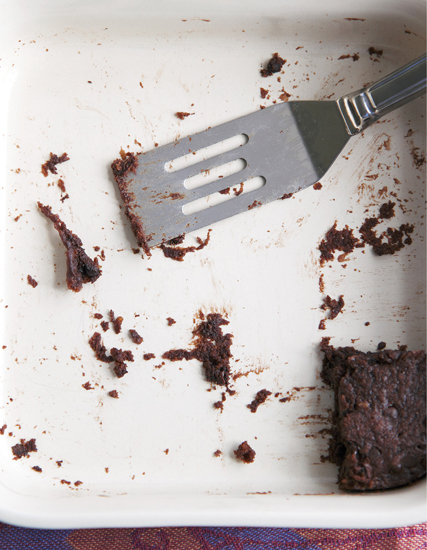
Acknowledgments
*
There are many people who supported and encouraged me on this journey. First, I must thank my husband, Harry, who not only taught me everything he knows about photography, but took my publicity photo, and encouraged me (and asked for status) every day. To all of my friends and family who tried my recipes, gave me feedback, and tried them again until they were perfectI thank you. Special thanks to those who regularly eat gluten, wheat, dairy, eggs, and soy, but were compelled to eat what I baked instead (especially those who did so on a daily basis). There were many who inspired me, including Kevin with his never-ending optimism, Andree with her examples of joyful living, Anna with her ease in the kitchen, and Patrick who happily embraces the foods he can eat. Thank you to my mother for sharing her love of chocolate with me.
Thank you to Shelly Loveland and Devon Wickens, who provided feedback on drafts, cheered me on, and helped to bring life to the words on the page. Thanks to my agent, Shawna Morey, who instantly recognized that this book was needed. To Matthew Lore for taking a chance on me as a new author, and providing exactly the right guidance at the right time. And to Matthew, Molly, Karen, Jack, and the superb extended team at The Experiment for making this book come alive. Thank you to Susi Oberhelman for designing a cover that I fell in love with the moment I saw it, to Iris Bass for fine-tuning my words, and to Pauline Neuwirth for a fabulous book design.
A special thank you goes to Dr. Stephen Wangen for writing an inspiring foreword, and to all of the doctors and medical professionals who take a practical approach to diagnosing and treating food-related medical issues.
Thank you to all of the mentors, teachers, and authors who inspired me and encouraged me, including Alisa Fleming, Monica Bhide, Kristin Taliaferro, Dianne Jacob, Jules Dowler Shepard, Lori Sandler, and Chef Richard Coppedge. Thank you to the many followers of Learning to Eat Allergy-Free, for reading, caring, and sharing.
Most important, I must thank my grandmother, Stella Laferriere. While she hasnt been with us in physical presence for some time, she is still here in spirit. I am quite certain she would be tickled pink to be able to hold this book in her hands.
Appendix A
Troubleshooting Recipes
Ive had my share of baking mishaps. Sometimes I accidentally leave out an ingredient or skip a step. I recommend always assembling the ingredients required for the recipe before you begin and checking off each step as you go.
As you experiment and make changes, do so incrementally. Dont add more flour, change the shortening, and add more baking powder all at once. If it works youre in luck, but if not, you wont know what steps to take next. If youre working on a new recipe, try scaling it down and making just half or one quarter of the recipe (be sure to keep proportions in sync).
You should always read through the recipe instructions before you start, and have all the tools and ingredients you need ready to go. But even if you follow the recipe to the letter, things can go wrong. Keep in mind that baking is a scienceand in all science we learn by making mistakes, in addition to proving what works.
I believe there is no such thing as a stupid question. While so many cookbook authors take for granted that everyone knows the basics, I strive to explain even the simple stuff. In this appendix I share some common allergen-free baking problems, and tips for how to solve them.
Problem: My cakes/muffins/quick breads dont rise.
solution: First, your baking powder or baking soda to make sure it is still good. If you are using only baking soda, make sure you have an acid in your recipe. If so, then add 1 to 2 teaspoons of baking powder. If you are using baking powder and you have tested it to make sure it is still good, try increasing the amount by 1 to 2 teaspoons.
Problem: My cake/muffin/quick bread batter is too lumpy.
Solution: Make sure you bring all of the ingredients to room temperature before you begin mixing. Blend the dry ingredients extremely well (either by hand or with your mixer) before adding any liquids. Break up any lumps. If this doesnt resolve the problem, you may be using a heavy flour blend that is absorbing too much liquid. See the next problem.
Problem: My cakes/muffins/quick breads are too dry.
Solution: You may be using a flour blend that is too heavy. Many gluten-free flours are considerably heavier than wheat flours, and absorb more liquid. See suggestions on used to compensate for the weight.
Problem: My cakes/muffins/quick breads fall flat before I take them out of the oven.
Solution: Make sure your oven reaches the suggested baking temperature before you start to bake (this is called preheating). Make sure you dont open the oven door (to peek, or to test for doneness) until the baked goods are near the end of the suggested baking time. If you still have problems, check the temperature of the oven for accuracy. To check, set the oven to 350F. Place an oven-safe thermometer in the center of the center rack. After 15 minutes, the thermometer should read 350F. If its not accurate, the next time you bake you should adjust the setting on your oven to compensate (either up or down accordingly). For example, if your oven was set to 350F and the thermometer reads 325F after your test, then set the oven temperature at 375F when the recipe suggests 350F. Conversely, you would set the oven temperature lower if your test resulted in a temperature higher than 350F.
Problem: My scone/doughnut batter sticks to my hands while Im trying to work with it.
Solution: When working with thick batters, its better to use water to keep your dough from sticking, rather than extra flour. Run your fingers under warm water and shake off any drops. Use slightly wet hands to form your pastry. Sprinkle a few drops of warm water on your prep surface, and on your bench knife, if needed.
Problem: My cookie or pie dough is too crumbly.
Solution: Many dough recipes will have 1 to 2 tablespoons cold water as needed listed as an ingredient. Cookie or pie dough should be just moist enough so the dough holds together, but not wet. Add additional cold water tablespoon at a time, so you can get to just the right consistency. If having added all of the additional water suggested, your dough is still too crumbly, use a little bit less flour the next time.
Problem: My dough is too sticky.
Solution: You may have added too much water as you formed the dough. Work in a little bit of additional flour (go easy, add just 1 tablespoon at a time), until you achieve the right consistency. Next time, use less water or liquid, and add the water more slowly ( tablespoon at a time).
Problem: My pie dough sticks to my rolling pin.
Solution: I prefer not to use flour to keep pie dough from sticking. Instead, spread a layer of wax paper or parchment paper over your dough before you begin rolling. When finished, gently peel the paper back to reveal your crust.
Problem: My cookies spread too much and burn around the edges.

